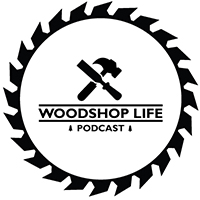Support us on Patreon: https://www.patreon.com/woodshoplife
Sean
1) Jolly good day Guy, Huy, and Sean. I’ve always found the imperfections in wood like knots, funky grain, and discoloration to be interesting. I have decided to try and start using them more as design aspects in my projects. I am tackling using a knot for the first time and other than “use epoxy” I am at a loss as to what brand, type and tints. There is a myriad of options. Any recommendations on products, methods and tints for an end table top knot in mixed clear/brown yellow birch? As always, thank you for sharing the knowledge! –
I want to Stabilize mostly, but I have heard that clear epoxy yellows. Should I tint darken to handle that? Daniel Stickman Woodworking
2) Thank you guys for everything you do with the podcast. My question for you is about table top flattening. My current situation is with a 42”x90” dining room table that went a little wonky during the glue up. A couple of the boards came out of alignment with the rest and so now the top is not flat. I know where I messed up and how to prevent this in the future, but I’m wondering what your suggestions would be to flatten a top of this size back to everything being even. I am currently using my router sled to do this and it is very time consuming. Thank you in advance for you answers. Sincerely, David Glowacki
3)Hey guys. I love the podcast. I learn something new from each episode. Thank you for answering my question and all the hard work you put into your tube and podcast.
I’m currently working very hard to increase my brand recognition to try and make wood working a full time thing. I know none of you have your own “Full time woodworking gig”. and I feel that is a choice. It seems like you guys could break out full time. Any advice on how to increase my reach to people to start bringing in more business would be super appreciated.
Scott Bonin @tomrarwoodworks
Huy
1) Thank you for the great podcast! I listen to it all the time and get so much out of it!
I just recieved a free delta unisaw with sliding table. Two question on this table saw:
1: This saw does not have a riving/splitter. Thoughts on adding one??
2: I want to rebuild my shop around this saw. Right now my table simply butts to my work bench which is also my out feed table. I would like to attach the bench/outfeed table to the saw but the floor is not level. (garages shop). Would you build to level? ie, level the saw and build everything to that plane or build to square with the floor.
Great pod cast! Great people! GREATEST INFO! Scott
2) Hi folks – I am moving in the next year, and am hopeful that I can sell many of my current stationary tools and move up to some used industrial-scale equipment. However, I have never purchased equipment that I couldn’t transport myself or simply have dropped off with lift gate service. I am interested to hear any advice regarding the transportation of large tools back to the shop after winning them at auction far from home (for example). I love my Toyota Tacoma but I’d be limited to picking up one tool at a time, which would be a real scheduling nightmare. Does one hire riggers to load a truck, have the truck driven to one’s own place, and hire riggers to get the stuff off the truck? I don’t have a forklift or anything like that (yet), and as much as I would love to I would rather direct my funds at tools vs material handling equipment. I am simply an enthusiastic amateur looking to get into large equipment for both the fun and the machines’ capacity. Andrew
3) The amount of information you all have given to the community has helped out so many folks and I’d like to say thank you for your knowledge and dedication.
My question is in the concerns of a L fence. I have been hearing about them lately and would like to know if any of you have used one. From what I have seen and understand is it increases the safety of making certain cuts. Could you help us understand what an L fence is and if it’s worth making.
Again, thank you all for the information you have given to us all.
Brent Jarvis Clean Cut Woodworking
